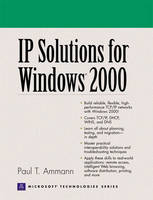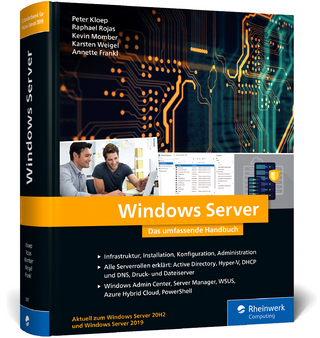
IP Solutions for Windows 2000
Prentice Hall (Verlag)
978-0-13-091170-4 (ISBN)
- Titel ist leider vergriffen;
keine Neuauflage - Artikel merken
This expert tutorial/reference gives enterprise IT professionals serious, comprehensive guidance on Windows 2000 TCP/IP, DHCP, WINS, and DNS: planning, migration, deployment, management, and troubleshooting. Networking expert Paul Ammann provides specific scenarios and Windows 2000 solutions for the most common networking challenges, from interoperability to remote access. Using practical, real-world examples, he illuminates every corner of Windows 2000 TCP/IP: architecture, installation, configuration, routing, WINS/DNS name resolution, dynamic DNS, and more. You'll find crucial information on how Windows 2000's TCP/IP implementation differs from Windows NT 4.0, how it differs from the IETF standards, and how to make it work in your environment. Among the topics Ammann covers in depth: supporting TCP/IP clients, setting up options, modifying server defaults, monitoring, optimization, and interoperability. He also presents step-by-step techniques for implementing cost-effective remote management, dynamic setup, roaming users, intelligent Web browsing, software distribution, printing, PPP dial-up, and many other key network applications.
The book is extensively cross-referenced, making it easy for network professionals to find the real-world answers they need right now.
PAUL T. AMMANN has more than 14 years of across-the-board networking experience in enterprise Windows, Novell, and UNIX environments. He has configured and troubleshot Cisco routers, conducted network performance analyses, and solved a wide range of network infrastructure problems encompassing both LANs and WANs.
Preface. 1. TCP/IP Overview. TCP/IP for Windows 2000. TCP/IP Background. The TCP/IP Model. TCP/IP Utilities. New TCP/IP Features for Windows 2000. Security Features of TCP/IP for Windows 2000. Core Protocols of TCP/IP. IP Addressing and Routing. Name Resolution. TCP/IP Configuration Items. TCP/IP Configuration Methods. Installing TCP/IP. Numbering Your Network. Default Gateways. Advanced Configuration. 2. Installing, Managing, and Diagnosing TCP/IP. Install TCP/IP. Configure TCP/IP. Install Simple TCP/IP Services. Remove TCP/IP. View the IP Routing Table. Add a Static IP Route. Remove a Static IP Route. Enable IP Forwarding. Test a TCP/IP Configuration by Using the Ping Command. Test TCP/IP Connections by Using the Ping and Net View Commands. Trace a Path by Using the Tracert Command. View the NetBIOS Name Table by Using the nbtstat Command. Release and Refresh NetBIOS Names by Using the nbtstat Command. View the Address Resolution Protocol Cache. Add a Static ARP Cache Entry. View Current TCP/IP Protocol and Connection Statistics. 3. DHCP Overview. DHCP Defined. Benefits of Using DHCP. How DHCP Works. DHCP Terminology. DHCP Tools. New Features. DHCP in IPv6. DHCP Servers. DHCP Clients. DHCP/BOOTP Relay Agents. DHCP in Windows 2000. DHCP Options. Understanding User and Vendor Classes. BOOTP and DHCP. The DHCP Database. 4. Using DHCP. Planning DHCP Networks. Managing DHCP Servers. Setting Up Scopes. Supporting Clients. Setting Up Options. Interoperability Issues. 5. Installation and Administration of DHCP Servers and Clients. Install a DHCP Server. Open the DHCP Console. Connect to a DHCP Server. Disconnect From a DHCP Server. Start or Stop a DHCP Server. Reconcile the DHCP Database. Manually Compact or Repair the DHCP Database. Remove or Uninstall DHCP. Authorize a DHCP Server in Active Directory. Delegate Ability to Authorize DHCP Servers to a Nonenterprise Administrator. Selectively Set DHCP Server Bindings for Network Connections. Add a User or Group as a DHCP User at a Member Server. Add a User or Group as a DHCP User at a Domain Controller. Add a User or Group as a DHCP Administrator at a Member Server. Add a User or Group as a DHCP Administrator at a Domain Controller. Enable Server Statistics to Automatically Refresh. Enable DHCP Server Logging. Enable Address Conflict Detection. Enable DNS Dynamic Updates for Clients. Manually Refresh Server Statistics.View DHCP Server Statistics. View DHCP Server Properties. Create a New Scope. Remove a Scope. Exclude an Address from a Scope. Activate a Scope. Deactivate a Scope. Change or View Scope Properties. Reconcile a Scope. Create a Superscope. Remove a Superscope. Add a Scope to a Superscope. Activate a Superscope. Deactivate a Superscope. Create a Multicast Scope. Remove a Multicast Scope. Set the Multicast Scope Time-to-Live Value. Specify a Finite Lifetime for a Multicast Scope. Assign a Server-based Option. Assign a Scope-based Option. Assign an Advanced (Class-Based) Option. Create a New User or Vendor Class. Define a New Option. Modify an Option. Remove an Option. View Client Lease Information. Delete a Client Lease. View, Release, or Renew a Client Address Lease. Set DHCP Class ID Information at a Client Computer. Show DHCP Class ID Information at a Client Computer. Add a Client Reservation. Change Information for a Reserved Client. Assign an Option to a Reserved Client. Configure Advanced (Class-Based) Options for a Reserved Client. Change the Reserved IP Address for a Client. View the BOOTP Table. Add an Entry to the BOOTP Table. Add Dynamic BOOTP Client Support to a Scope. Change the Lease Time for Remote Access Clients. Optimize the Command Prompt for Use with Command-line Tools. Use DHCP Commands Interactively at the Command Prompt. Use DHCP Commands Noninteractively or in Scripts. 6. WINS Overview. WINS Defined. Benefits of Using WINS. When to Use WINS. How WINS Works. WINS Tools. New Features. NetBIOS Over TCP/IP Concepts. Locating Network Services. WINS Components. WINS Replication. WINS Resolution. WINS Features. 7. Using WINS. Planning WINS Networks. Configuring WINS Replication. Using Static Mappings. Modifying Server Defaults. WINS Database Management. Interoperability Issues. Migrating from WINS to DNS. Install a WINS Server. Open the WINS Console. Add a WINS Server to the Console. Remove a WINS Server from the Console. Start or Stop a WINS Server. Decommission a WINS Server. Remove or Uninstall WINS. Modify Backup Settings. Modify Name Record Settings. Modify WINS Logging Properties. Modify Burst Handling Properties. Set the WINS Database Path. Increase the Starting Version Count. Disable LAN Manager Compatibility. View WINS Server Statistics. Reset WINS Server Statistics. Modify Auto-Refresh of WINS Statistics. Export WINS Console Data to a Text File. Modify the WINS Console View. Configure WINS for Non-DHCP Clients. Configure WINS for DHCP-enabled Clients. Disable WINS/NetBT Name Resolution. Verify WINS Registration of Client NetBIOS Names. Search for Names That Begin with a Specified Set of Characters. Show All Records in the WINS Database. View Properties for a Selected WINS Record. View or Download the WINS Database by Owner. Filter the WINS Database View. Clear All WINS Data Filters. Add, Modify, or Remove a Filter Type. Scavenge the WINS Database. Backup the WINS Database. Restore the WINS Database. Delete or Tombstone an Entry in the WINS Database. Delete an Owner from the WINS Database. Enable Periodic Consistency Checking of the WINS Database. Manually Check Database Consistency. Check Version Number Consistency Between Servers. Add a Replication Partner. Delete a Replication Partner. Enable Replication with Non-Partner WINS Servers. Modify Push Partner Properties. Modify Pull Partner Properties. Enable Automatic Partner Configuration. Start Replication Immediately. Send a Replication Trigger to a Selected Partner. Send a Replication Trigger to Any Specified WINS Server. Block Replication of Records Owned by a Specified Server. Change a Replication Partner Type. Enable the Use of Persistent Connections with a Partner Server. Enable the Use of Persistent Connections with Pull Partners. Enable the Use of Persistent Connections with Push Partners. Add a Static Mapping Entry. Edit a Static Mapping Entry. Import a File Containing Static Mapping Entries. Enable Static Mappings to be Overwritten During Replication. Optimize the Command Prompt for Use with Command-Line Tools. Use WINS Commands Interactively at the Command Prompt. Use WINS Commands Noninteractively or in Scripts. 8. DNS Overview. DNS Defined. DNS Tools. Server Features. Client Features. DNS Domain Names. How DNS Query Works. Understanding Zones and Zone Transfer. Reverse Lookup. Dynamic Update. Windows 2000 DNS Implementation. 9. Using DNS. Planning Issues. Managing Servers. Managing Clients. Managing Zones. Monitoring and Optimizing Servers. Advanced Server Configuration. 10. Installing and Maintaining DNS Servers. Install a DNS Server. Configure a DNS Server for Use with Active Directory. Configure a New DNS Server. Add a Secondary Server for an Existing Zone. Install a Caching-only DNS Server. Restrict a DNS Server to Listen Only on Selected Addresses. Have a DNS Server Use Forwarders. Configure DNS for Static Clients. Enable DNS for DHCP-Enabled Clients. Configure the Primary DNS Suffix for a Client Computer. Preload the Client Resolver Cache. Open the DNS Console. Start or Stop a DNS Server. Add a Server to the DNS Console. Remove a Server From the DNS Console. Manually Update Server Data Files. Change the Boot Method Used by the DNS Server. Change the Name-Checking Method Used by the DNS Server. Enable or Disable Fast Transfer Format During Zone Transfers. Prevent Loading of a Zone When Bad Data Is Found. Disable Round Robin Rotation for Multihomed Names. Disable Local Subnet Prioritization for Multihomed Names. Restore Server Default Preferences. Disable Recursion on the DNS Server. Update Root Hints on the DNS Server. Secure Server Cache Against Names Pollution. Clear the Server Names Cache. Select and Enable Debug Logging Options on the DNS Server. Disable Debug Logging Options on the DNS Server. Test a Simple Query on the DNS Server. Test a Recursive Query on the DNS Server. Enable Automatic Query Testing on the DNS Server. View the DNS Server System Event Log. View a DNS Server Debug Log File. Add a Forward Lookup Zone. Add a Reverse Lookup Zone. Delete a Zone. Pause a Zone. Start a Zone. Change a Zone File Name. Modify the Start of Authority Record for a Zone. Create and Manage a Notify List for a Zone. Create a Zone Delegation. Specify Other DNS Servers as Authoritative for a Zone. Update the Master Server for a Secondary Zone. Enable DNS to Use WINS Resolution. Allow Dynamic Updates. Allow Only Secure Dynamic Updates. Initiate a Zone Transfer at a Secondary Server. Adjust the Refresh Interval for a Zone. Adjust the Retry Interval for a Zone. Adjust the Expire Interval for a Zone. Modify Security for a Directory Integrated Zone. Add a Host Resource Record to a Zone. Set Aging and Scavenging Properties for the DNS Server. Set Aging and Scavenging Properties for a Selected Zone. Enable Automatic Scavenging of Stale Resource Records. Start Immediate Scavenging of Stale Resource Records.View When a Zone Can Start Scavenging Stale Records. Reset Scavenging and Aging Properties for a Specified Resource Record. Display and View a Client Resolver Cache Using the ipconfig Command. Flush and Reset a Client Resolver Cache Using the ipconfig Command. Renew DNS Client Registration Using the ipconfig Command. Verify DNS Server Responsiveness Using the nslookup Command. Verify a Zone Delegation Using the nslookup Command. Verify DNS Registration for Domain Controllers Using the nslookup Command. Verify WINS as the Source for Answering a DNS Query. Appendix A: TCP/IP Resources. TCP/IP Resources. TCP/IP RFCs. TCP/IP References. Converting Binary to Decimal. TCP/IP Utilities. TCP/IP Database Files. Using Performance Logs and Alerts. Troubleshooting. Appendix B: DHCP Resources and Troubleshooting. DHCP Resources and Troubleshooting. DHCP Options Reference. DHCP RFCs. DHCP Database Files. Netshell Commands for DHCP. DHCP Performance Monitoring Reference. DHCP Updated Technical Information. DHCP Bibliography. Troubleshooting. Appendix C: WINS Resources and Troubleshooting. WINS Resources and Troubleshooting. NetBIOS Names Reference. Netshell Commands for WINS. WINS RFCs. RFCs for WINS in Windows 2000. Obtaining RFCs. WINS Performance Monitoring Reference. WINS Updated Technical Information. WINS Bibliography. Troubleshooting. Appendix D: DNS Resources and Troubleshooting. DNS Resources and Troubleshooting. Resource Records Reference. DNS Server Log Reference. DNS-related Files. DNS Updated Technical Information. DNS RFCs. Top-Level Domains. DNS Bibliography. Troubleshooting. Appendix E: TCP/IP Utilities. TCP/IP Utilities. Arp. Finger. Ftp and Commands. Hostname. Ipconfig. Lpr. Lpq. Nbtstat. Net: Command Options. NetSh. Netstat. Nslookup. Pathping. Ping. Rcp. Rexec. Route. Rsh. Tftp. Tracert. Index.
| Erscheint lt. Verlag | 28.3.2001 |
|---|---|
| Verlagsort | Upper Saddle River |
| Sprache | englisch |
| Maße | 178 x 235 mm |
| Gewicht | 990 g |
| Themenwelt | Informatik ► Betriebssysteme / Server ► Windows |
| Informatik ► Betriebssysteme / Server ► Windows Server | |
| Mathematik / Informatik ► Informatik ► Netzwerke | |
| ISBN-10 | 0-13-091170-4 / 0130911704 |
| ISBN-13 | 978-0-13-091170-4 / 9780130911704 |
| Zustand | Neuware |
| Haben Sie eine Frage zum Produkt? |
aus dem Bereich


